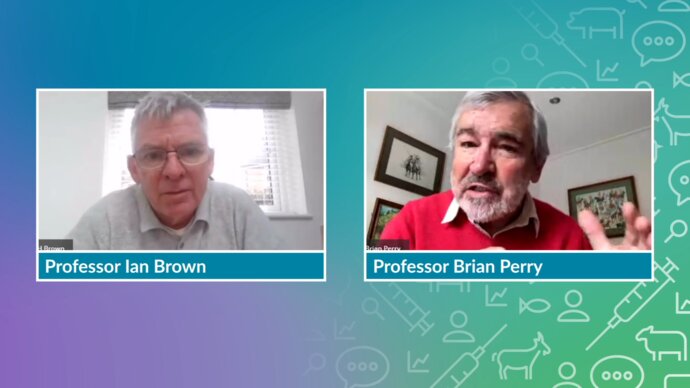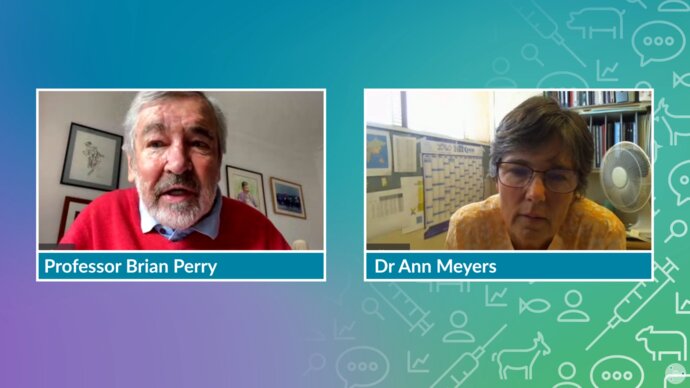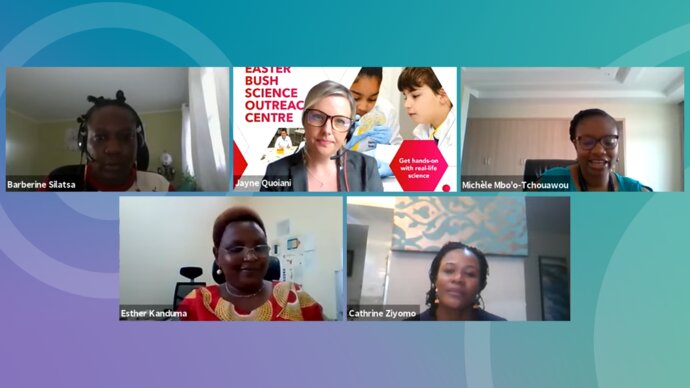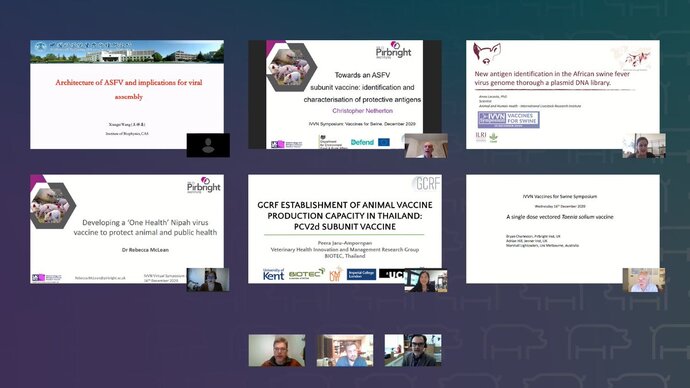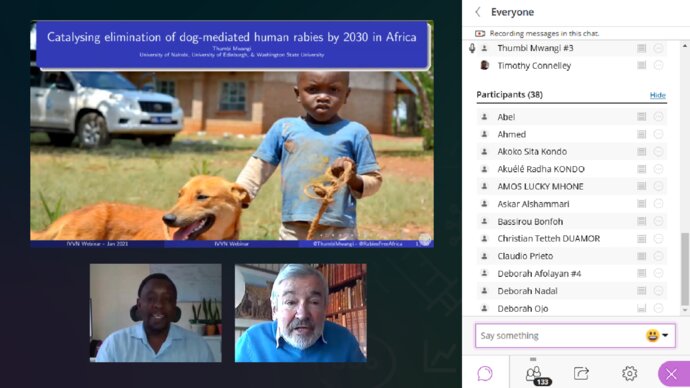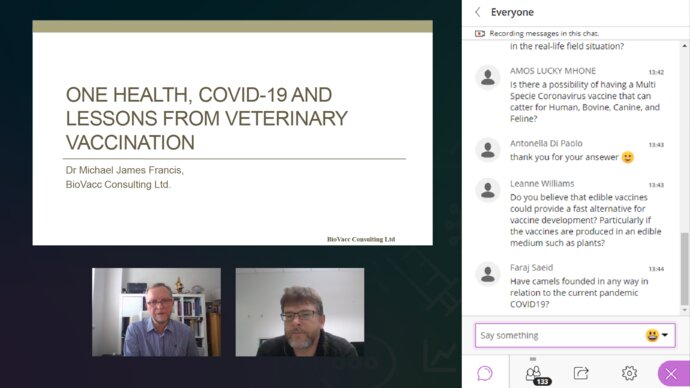Virtual symposium on poultry vaccines sees IVVN partnering with GCRF One Health Poultry Hub
Seven speakers from five countries took part this week in a virtual symposium on vaccines for poultry, co-hosted by the IVVN and the GCRF One Health Poultry Hub. The event was chaired by the One Health Poultry Hub's director, Professor Fiona Tomley, and Professor Hualan Chen from the Harbin Veterinary Research Institute in China, and was the second in a series of virtual symposia organised by the IVVN.
Bringing members together is a core component of the IVVN's activities, and our 2018 and 2019 conferences in Nairobi and London were hugely successful meetings. But, our third annual conference, scheduled to take place in March 2020 in Hanoi, Vietnam, unfortunately had to be cancelled because of the Covid-19 pandemic. Instead, we decided to host the original Hanoi 2020 programme, which was divided into four host group-specific themes, as a series of online symposia.
The poultry symposium was opened by the IVVN's director, Dr Timothy Connelley, who welcomed our 130 delegates to the event. Professor Fiona Tomley then chaired the first session of the symposium, which began with a presentation by Professor Brendan Wren from the London School of Hygiene and Tropical Medicine. Professor Wren spoke about his work developing recombinant glycoconjugate vaccines, which have long been used in humans, but not in animals because of their traditionally prohibitive cost. Professor Wren and his colleagues have developed new methods for producing glycoconjugate proteins, allowing much cheaper production.
The second presentation was given by Professor Hualan Chen, who spoke about her lab's research on influenza viruses. Professor Chen and her colleagues have developed inactivated, virus-vectored and DNA vaccines against influenza viruses. Her presentation discussed the H7N9 virus, a zoonotic strain of avian influenza with pandemic potential that first emerged in 2013. Professor Chen led a vaccination effort using an H5/H7 bivalent inactivated vaccine in poultry, successfully eliminating human infection with the H7N9 virus.
The third talk also covered avian influenza, with Professor Munir Iqbal from the Pirbright Institute in the UK presenting his efforts to induce faster and stronger immunity against avian influenza by selectively targeting vaccine antigens to chicken antigen-presenting cells. The vaccine developed by Professor Iqbal and his team induced faster and higher antibody responses, and chickens immunised with the vaccine showed less viral shedding than a control group.
A poster and networking session was held between during a break between talks. Each poster was presented in a breakout room, with participants free to move between rooms to browse the posters and discuss with the presenters. The four posters were presented by Dr Angela Makumi from the International Livestock Research Institute in Kenya, Dr Mariatulqabtiah Abdul Razak from Universiti Putra Malaysia, Professor Aijian Qin from Yangzhou University in China, and Dr Muhammad Zubair Shabbir from the University of Veterinary and Animal Sciences in Pakistan.
After the break, the second session of talks began with Professor Susantha Gomis from the University of Saskatchewan in Canada, who spoke about innate immunity and delivery of immunostimulatory agents to neonatal broiler chickens. Professor Gomis' research group has shown that oligodeoxynucleotides containing CpG motifs can be delivered as micro droplets, leading to protection of broiler chicks against challenge with lethal doses of Escherichia coli, which may offer a safe and effective alternative to the use of antibiotics.
For the fifth talk, we returned to the subject of avian influenza, with a presentation on H9N2 viruses by Melina Jonas from PT Medion Farma Jaya in Indonesia. This low pathogenic avian influenza subtype has spread throughout Indonesia since 2016. The team at Medion isolated H9N2 viruses from vaccinated and unvaccinated flocks in backyard and commercial farms in Indonesia in 2019, and looked at pathogenic signs. Broilers, layers, breeders and native chickens were all affected and, although the newly isolated viruses phylogenetically clustered with 2016-2017 isolates, the 2019 cases showed more severe pathogenic signs in the kidneys and intestines, with less obervable tracheal and heart haemorrhage.
The final two presentations featured IVVN pump-priming grant awardees talking about their projects. Dr Kate Sutton from the Roslin Institute, UK, spoke about a completed project she led, which involved testing edible vaccines in chickens. Dr Sutton and her collaborators delivered vaccines against the poultry parasite Eimeria in the form of a novel oil formulation. This vaccine induced both a systemic and mucosal immune response to model antigens, and has the potential to be mixed into chicken feed for simple administration.
The last talk of the symposium was given by Dr Mariatulqabtiah Abdul Razak from Universiti Putra Malaysia. Dr Razak's IVVN pump-priming project will test the immunogenicity of nodavirus-like particles, which have previously shown promising results in mice models, in chickens. These particles, displaying matrix 2 ectodomain proteins from avian influenza viruses, could be used as universal vaccines against avian influenza viruses in chickens. The work has already begun, with the nodavirus capsid constructed, and future work will focus on in vivo experiments and challenge studies.
All the talks were recorded, and the video is available to watch below this article.
We would like to thank all our presenters for their fantastic talks and poster presentations, and our chairs for ensuring the smooth running of the talks and moderating the questions. Thanks also to our co-hosts at the GCRF One Health Poultry Hub, and our sponsors at Zoetis, The Bloomsbury SET and Phibro Animal Health. And, of course, thanks to everyone who attended the symposium and contributed to the discussion.
The next symposium in our series is on Vaccines for Ruminants, and will take place on Monday 26 April 2021.
